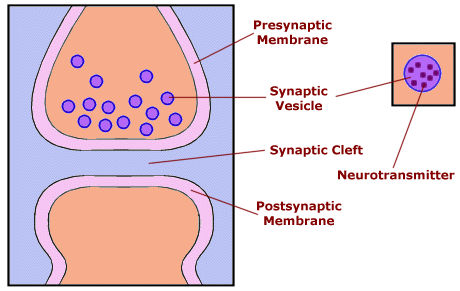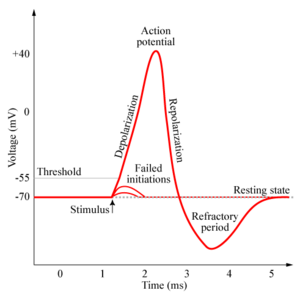
Mechanism of Synaptic Transmission

Taken from: www.columbia.edu/.../ transmission.html
Neurotransmitters, such as Acetylcholine, are stored in vesicles in the presynaptic terminal. Acetylcholine is secreted across synaptic clefts, where it binds to the post synaptic membrane and causes a change in the permeability of the postsynaptic cell, which results in an excitatory post-synaptic potential.
The mechanism of synaptic transmission of neurotransmitter is initiated by an action potential in the presynaptic cell. An action potential is a brief reversal of the resting potential, it can be described as a wave of depolarisation.

Taken from: www.answers.com/ topic/action-potential
The method of synaptic transmission is outlined below:
1. An action potential arrives at the synaptic knob.
2. This causes calcium channels to open, allowing Ca2+ ions to flow into the synaptic knob.
3. The increase in the calcium ion concentration causes vesicles, containing the acetylcholine neurotransmitter, to move to the presynaptic membrane.
4. The vesicles fuse with with the presynaptic membrane and discharge their content into the synaptic cleft.
5. Molecules of acetylcholine then diffuse across the gap and fit into specific receptor sites on the postsynaptic membrane.
6. This then causes an alteration in the permeability of the postsynaptic membrane, which results in a movement of ions. Na+ ions flow inwards, building up a charge known as the exitatory postsynaptic potential (EPSP).
7. Once the EPSP reaches a threshold, an action potential is generated in the neurone.
8. The acetylcholine is then broken down in the cleft by the enzyme acetylcholinesterase.
9. The products of breakdown are reabsorbed into the synaptic knob, where they are resythesised .
The resting potential is a charge across the axon membrane caused by an unequal distribution of ions. The outside of the membrane is positive with respect to the inside.
After the stimulus occurs, sodium gates open and Na+ ions flood inwards, reversing the polarity. The sodium gates then close and a pump mechanism restores the resting potential. When this action potential is received in the synaptic knob the movement of Ca2+ ions into the knob is promoted and hence the process of synaptic transmission of neurotransmitter begins.